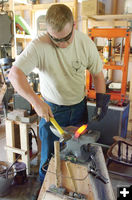

Finished blades
Finished blades display unique patterns. Photo by Kootenai Valley Record.
|


Phil Kilbreath
Phil Kilbreath heats layers of steel in a forge as part of the pattern welding process. Photo by Kootenai Valley Record.
|


Hammering
Phil Kilbreath hammers a glowing hot piece of steel into shape. Photo by Kootenai Valley Record.
|
|
Warden practices metalsmithís art
by Brent Shrum, Kootenai Valley Record
September 2, 2011
When heís not patrolling the woods and waters of Lincoln County in his day job as game warden for Montana Fish, Wildlife and Parks, Phil Kilbreath is working to perfect an ancient art of combining disparate pieces of steel into beautiful and functional blades.
Kilbreath knew a professional knife maker when he was growing up and made his first knives when he was 11 or 12 years old, but it wasnít until recently, after moving to Troy, that he started making his own blades in earnest.
"About a year or a year and a half ago, I read a book about the Vikings and it talked about their pattern welded swords, and that got me interested," he said.
Pattern welding is a technique used by the Vikings and other early cultures to combine steels with different qualities into a single blade. Multiple thin layers of steel are placed together and heated in a forge, then hammered together and folded over numerous times, leading to a finished product that is both functional and decorative. When an etching compound is applied at the end of the process, the different steels take on different shades, revealing a pattern in the metal.
Kilbreath read about pattern welding on the internet and found that itís not considered to be suitable for beginners.
"It was almost as much the challenge as anything else, because itís an advanced technique," he said.
"And of course, the end result is just gorgeous."
Before long, Kilbreath was setting up a shop in his garage to try his hand at pattern welding.
"I convinced my wife to let me buy a forge and an anvil, and itís been all downhill since then," he said.
Kilbreath buys his steel in small, flat pieces that he clamps together in 11 layers of alternating type. The steel is put into the forge until it glows a bright orange, then pressed and hammered to weld it together. A hydraulic press saves some of the work, but the hammer and anvil remain essential tools and the process is repeated and the steel is folded over again and again.
By repeating the folding of the steel, the number of layers increases. More layers result in a finer pattern in the finished blade, while fewer layers result in a bolder pattern. Kilbreathís blades usually end up with between 60 and 150 layers.
"I donít know what it is that fascinates me so much about this process, but if you take two separate objects and make them into one solid object, it almost seems like it shouldnít work," Kilbreath said.
Once the welding process is complete and the steel starts to take the rough shape of a blade, itís annealed by cooling it in ashes, which softens the steel and allows it to be shaped. Kilbreath doesnít use a pattern when finishing a blade, depending instead on "what the piece of metal looks like, and what my eye sees."
"None of them are ever the same," he said.
After the blade is shaped and ground, itís heat treated and quenched in oil to harden it, then tempered in an oven to soften it again and take the brittleness out of it. Kilbreath usually uses wood to make the handles on his hunting knives, but heís also used leather washers.
Kilbreath takes orders for knives when he has the time to make them, with prices usually in the $100 to $200 range depending on the details.
"My ultimate goal at this point in time is to sell enough knives to pay for my hobby," he said.
For more information, Kilbreath can be reached at 406-295-4394.
____________________________________________
Editor's Note: See the August 30, 2011 edition of the Kootenai Valley Record for the printed version of this story. The Kootenai Valley Record publishes once a week, on Tuesdays, in Libby, Montana. They are a locally owned community newspaper, located at 403 Mineral Avenue in Libby. For in-county and out-of-county subscription information, call 406-293-2424, or e-mail kvrecord@gmail.com.
|


